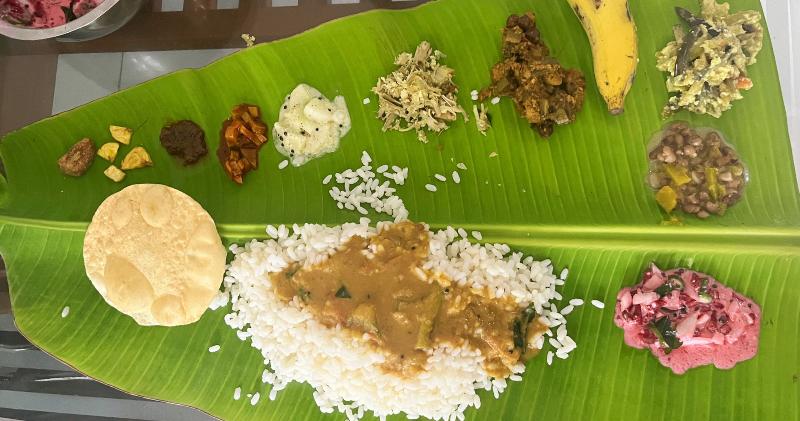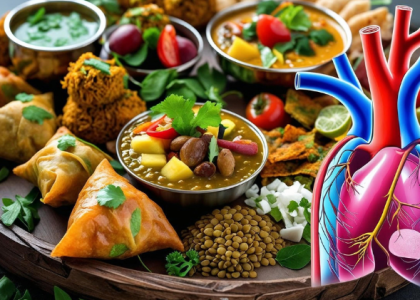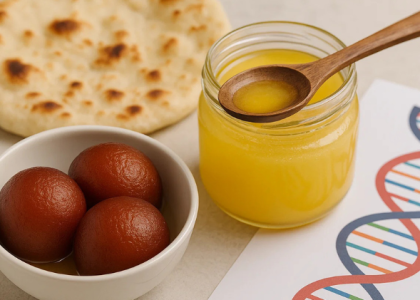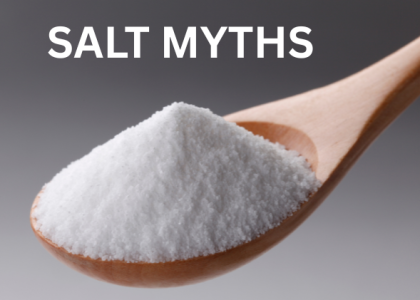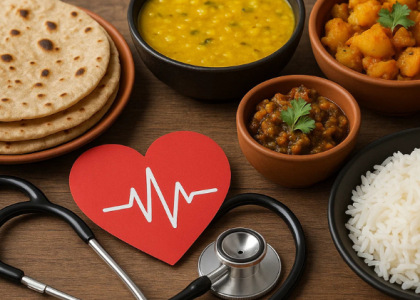My dad has been vegetarian for 40 years. No alcohol, no cigarettes, no meat—just dal, rice, and vegetables, exactly like his parents taught him. He proudly tells doctors about his “pure” diet and expects praise for his healthy lifestyle. So imagine his shock when his doctor recently said he’s prediabetic and at high risk for heart disease.
“How is this possible?” he asked me, genuinely confused. “I don’t eat any junk food. I follow our traditional diet.”
This story plays out in South Asian families worldwide every day. We’ve been taught that vegetarian equals healthy, that avoiding meat automatically protects us from heart disease and diabetes. But what if I told you that many South Asian vegetarian meals are actually driving epidemic rates of diabetes and heart attacks in our community?
The uncomfortable truth is that not all vegetarian diets are created equal. While our grandparents thrived on traditional plant-based eating, today’s South Asian vegetarian meals often look very different—and our hearts are paying the price. It’s time to look beyond the “vegetarian” label and examine what’s actually on our plates.
The South Asian Vegetarian Trap
Walk into any South Asian home during lunch time, and you’ll likely see a spread that looks healthy at first glance: dal, rice, vegetables, roti, and maybe some yogurt. No meat in sight—surely this must be heart-healthy, right?
Here’s what’s really happening on that plate: refined white rice that spikes blood sugar faster than a candy bar, deep-fried vegetables swimming in oil, parathas loaded with ghee, and sweet lassi that contains more sugar than a soda. Add the evening chai with sugar and a few fried snacks, and you’ve consumed more refined carbohydrates and unhealthy fats than someone eating a typical Western diet.
Traditional South Asian vegetarian meals have become a perfect storm of heart disease risk factors:
Refined Carbohydrate Overload: White rice, refined wheat rotis, and processed foods now dominate plates that once featured diverse whole grains and millets. These foods cause blood sugar spikes that damage blood vessels over time.
Fried Food Frequency: What were once special-occasion treats—pakoras, pooris, samosas—have become everyday staples. The oil used for frying is often reused multiple times, creating harmful compounds that promote inflammation.
Hidden Dairy Bombs: Paneer dishes, whole milk yogurt, ghee-laden vegetables, and milk-based sweets add saturated fat and calories that our ancestors consumed in much smaller quantities.
Fiber and Protein Gaps: Despite eating “vegetables,” many meals consist mainly of starchy options like potatoes and cauliflower, while missing the fiber-rich greens and protein-dense legumes that provide sustained energy and blood sugar control.
The result? You can be completely vegetarian and still develop high triglycerides, fatty liver disease, insulin resistance, and heart disease. The absence of meat doesn’t automatically create the presence of health.
What the Science Reveals
Research published in the landmark INTERHEART study shows that South Asians have the highest rates of heart disease globally—and this includes our vegetarian populations¹. Being vegetarian provided no protective effect against cardiovascular disease when the diet quality was poor.
The problem lies in how our bodies process the typical South Asian vegetarian meal. When you eat a plate of white rice with dal and vegetables cooked in oil, your blood sugar rises rapidly because there’s insufficient fiber and protein to slow absorption. This triggers a cascade of metabolic problems that accumulate over years.
Harvard School of Public Health research demonstrates that refined carbohydrates—the foundation of many South Asian vegetarian diets—increase insulin resistance and inflammation, both key drivers of heart disease². The irony is devastating: we avoid meat to protect our health, but the refined grains and fried foods we eat instead may be more harmful.
Studies in the Indian Journal of Endocrinology & Metabolism show that vegetarian South Asians often have metabolic profiles similar to their meat-eating counterparts when their diets are high in refined carbohydrates and unhealthy fats³. The British Heart Foundation notes that South Asian vegetarians have higher rates of diabetes than expected, largely due to dietary composition rather than the absence of meat⁴.
Think of it this way: your body needs building blocks (protein), fuel (healthy carbs), and maintenance tools (vitamins, minerals, healthy fats). A typical South Asian vegetarian meal provides lots of quick-burning fuel but often lacks the other essential components. It’s like trying to build a house with only bricks but no cement or foundation.
Hidden Red Flags in Your "Healthy" Meals
Before you panic about every meal, let’s identify the specific warning signs that your vegetarian diet might be working against your heart health:
Carb-Heavy Plate Syndrome: If your meals consist mainly of rice/roti with a small portion of dal and vegetables, you’re eating like a marathon runner without running the marathon. These meals spike blood sugar and leave you hungry again within hours.
The Daily Fry-Up: When fried foods appear more than twice a week—whether it’s fried okra, potato curry made with excessive oil, or daily pakoras with evening tea—you’re consuming restaurant-level calories at home.
Sugar Sneakiness: Three cups of sugary chai daily plus weekend sweets plus “healthy” fruit juices can add up to more sugar than the American Heart Association recommends for an entire week.
Starchy Vegetable Dominance: If your “vegetable” intake consists mainly of potatoes, cauliflower, and peas while avoiding leafy greens, you’re missing crucial nutrients and fiber that protect heart health.
Portion Distortion: Traditional Indian serving sizes were much smaller than today’s standard. That bowl of rice that seems normal? It might contain 3-4 servings worth of carbohydrates.
The Dairy Deluge: When paneer appears multiple times per week, when every meal includes yogurt or milk, and when ghee is used liberally, the saturated fat content can exceed that of many meat-based diets.
Make It Truly Heart-Healthy While Staying Vegetarian
The solution isn’t to abandon vegetarianism or your cultural foods—it’s to optimize what’s already on your plate. Small, strategic changes can transform a heart-risky meal into a heart-protective one.
Build Better Plates:
- Fill half your plate with non-starchy vegetables (leafy greens, bell peppers, broccoli, bitter gourd)
- Reserve one-quarter for whole grains or traditional grains like millets
- Dedicate one-quarter to protein-rich foods like dal, chickpeas, or small amounts of paneer
- Add a handful of nuts or seeds for healthy fats
Smart Cooking Swaps:
- Steam, sauté, or roast vegetables instead of deep frying
- Use minimal oil and choose heart-healthy options like mustard oil or olive oil
- Replace white rice with brown rice, quinoa, or traditional millets 2-3 times per week
- Make dal the star—increase portions and try different varieties for diverse nutrients
Rethink Snacks and Beverages:
- Swap fried evening snacks for roasted nuts, fruits, or homemade healthy options
- Reduce sugar in chai gradually, or try herbal teas with spices
- Replace fruit juices with whole fruits to get fiber along with sweetness
- Save traditional sweets for actual celebrations, not daily treats
Add Movement and Mindfulness:
- Walk after meals to help blood sugar control
- Practice stress reduction through meditation, yoga, or simple breathing exercises
- Ensure adequate sleep, as poor sleep worsens insulin resistance
- Stay hydrated with water rather than sugary beverages
Get the Right Tests: Don’t assume vegetarian equals healthy. Ask your doctor for:
- HbA1c to check blood sugar control over time
- Triglycerides (often elevated in high-carb diets)
- Waist-to-hip ratio (more telling than BMI for South Asians)
- Blood pressure monitoring
Rethink Vegetarianism: Quality Over Labels
The path forward isn’t about choosing between vegetarian and non-vegetarian—it’s about choosing nutrient-dense over calorie-dense, whole foods over processed foods, and balanced plates over carb-heavy meals.
Your vegetarian diet can be incredibly heart-protective when done thoughtfully. Traditional Indian cuisine offers an abundance of heart-healthy options: fiber-rich legumes, antioxidant-packed spices, diverse vegetables, and healthy cooking methods. The problem isn’t the tradition—it’s how we’ve modernized it.
You don’t need to eat meat to be healthy, but you do need to think beyond carbs, oil, and sugar. Every meal is an opportunity to nourish your body rather than just fill your stomach. Every cooking choice is a chance to honor your values while protecting your health.
Start with one change: add more vegetables to tomorrow’s lunch. Then gradually reduce oil in one dish. Replace one sugary chai with herbal tea. Small steps, taken consistently, create the biggest transformations.
Being vegetarian is a beautiful choice—for ethical, environmental, and spiritual reasons. But it’s not a free pass to ignore nutrition. By making your vegetarian diet truly nutritious, you’re not just protecting your own heart. You’re modeling healthy living for your children and proving that traditional values and modern health can work together beautifully
.
Your heart doesn’t care about labels—it cares about nutrients. Give it what it needs to keep beating strong for decades to come.
Ready to optimize your vegetarian diet for heart health?
📥 Download our “Heart-Healthy Desi Cooking Guide” with simple swaps that don’t compromise on taste
🧮 Take our Heart Risk Quiz to see how your current diet affects your cardiovascular health
🧡 Share this article with vegetarian family members who think they’re automatically protected from heart disease
References:
¹ INTERHEART Study – Risk factors for acute myocardial infarction in South Asians: https://www.ahajournals.org/doi/10.1161/CIRCULATIONAHA.107.705370
² Harvard School of Public Health – Carbohydrates and Blood Sugar: https://www.hsph.harvard.edu/nutritionsource/carbohydrates/carbohydrates-and-blood-sugar/
³ Indian Journal of Endocrinology and Metabolism – Dietary patterns and metabolic risk factors in South Asians: https://www.ijem.in/article.asp?issn=2230-8210
⁴ British Heart Foundation – South Asian Heart Disease Statistics: https://www.bhf.org.uk/informationsupport/publications/statistics/south-asian-factsheet
⁵ World Health Organization – Healthy Diet Factsheet: https://www.who.int/news-room/fact-sheets/detail/healthy-diet
